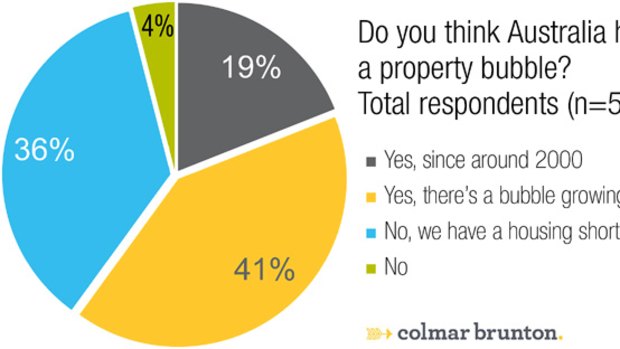By Adele Ferguson
It’s official: 60 per cent of investors believe Australia has a property bubble. A confluence of housing shortages, low interest rates, speculative fervour and last year’s move by the Rudd Government to relax foreign ownership rules on real estate have turbo-charged house prices.
But as John Maynard Keynes famously said: “A market can stay irrational longer than you can stay solvent,” and those looking for an imminent correction will find little evidence for it in investor attitudes.

Source: Colmar Brunton
Bubble risk: rates set to rise, RBA says
In the latest Investor Pulse survey, conducted jointly by BusinessDay and marketing research group Colmar Brunton, there is no indication that investor appetite for property will slow down soon.
When asked if it was a good time to buy an investment property, 67 per cent agreed that it was because the supply shortage would support rental and price yields. Another 21 per cent thought prices would stagnate and only 12 per cent believed that prices would fall.
On the future of the boom, 32 per cent could see it running another year, 44 per cent for two or more years, and 7 per cent forever. Contrary to recent years, respondents ranked Sydney as the strongest property market in the current cycle, followed by Melbourne, Brisbane, Perth, Adelaide, Canberra, Darwin and Hobart.
This is all scary stuff. Investors played a key role in expanding the property bubble through the late 90s. In 1990 investment loans represented 16 per cent of Australian mortgages at $13 billion. By 2008 that figure had ballooned 2400 per cent to $310 billion, or 31 per cent of total mortgages. Investor attitudes matter.
Despite 71 per cent of investors hypothetically believing there could be a property crash, the more common attitude is that other factors will keep the momentum going. They rank the following factors in order of importance: housing shortages; low interest rates; foreign purchases of Australian property; speculative fervour; negative gearing and moral hazard.
The survey revealed, however, that moral hazard may be much larger than investors themselves admit, with 42 per cent expecting the Rudd Government to introduce another round of first home buyer grants if the current boom shows signs of ending.
The increase in foreign purchases also cannot be under estimated, following the decision last March by the federal government to relax its rules on property ownership. This abolished mandatory reporting of such acquisitions in a bid to ''enhance flexibility in the market''.
Before the change, foreign investment in Australian residential property had already started increasing, up 33 per cent to $20.4 billion. It is not known what the figures stand at in 2010 but there are suggestions that more than 30 per cent of homes auctioned are purchased by foreign speculators. If this is the case, it will dramatically add to the property bubble.
It is a potential political time bomb. Numerous readers have written in complaining that they are being priced out of the market by overseas bidders.
One Investor Pulse reader wrote recently: “It would explain the highly overpriced market and the reason why local wages are not enough to purchase the average house. To rely on high immigration to keep the economy temporarily out of trouble is one thing, but allowing this foreign speculation to keep Australians out of their own market should be opposed with urgency.”
Another Investor Pulse reader wrote: “So much for Rudd's 'working families'. Australians should get priority over foreign investors for what limited housing we have. How can Australians compete when Chinese borrow at home at 1 per cent? The Australian property market is strong and doesn't need to be propped up. The Government should act now to stop this misguided and UN-Australian policy. Shame on you, Mr Rudd, for selling out on Working Families.”
Investors are divided on possible solutions to the outsized price rises. A majority, 54 per cent, are against interest rate rises. When it comes to government policy, investors ranked cutting stamp duty as their best solution, just ahead of building more public housing and re-limiting foreign investment.
Cutting immigration and negative gearing ranked lower. Another solution was also clear in the fact that 52 per cent of investors admitted they would reconsider the value of an investment property if the government reversed the 1999 capital gains tax cuts.
Investors clearly acknowledged the need for government intervention with 91 per cent seeing no solution coming from the private sector. Half reckoned banks will not lend to developers because their exposure to mortgages is already too high. Most of the other half agreed rather with the statement that the banks see the risk in overvalued prices and want to keep the market tight.
There was little sympathy for younger Australians with 55 per cent of investors agreeing first-home buyers were best off saving a deposit to get into the property market and 24 per cent suggesting the young could buy on the city fringe.
Another 27 per cent of surveyed investors already owned an investment property and 16 per cent were are seriously considering buying one.